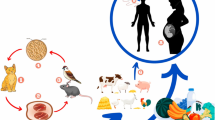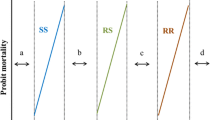Abstract
A herd-based study was carried out in Central Equatoria State, Southern Sudan, to study epidemiological aspects of tick-borne diseases. Six herds of cattle situated in three different locations were selected and investigated every 3 months during the year 2005. Blood smears for Giemsa staining and blood spots on filter paper for deoxyribonucleic acid extraction were collected from 600 apparently healthy indigenous cattle. A total of 69 (11.5%) samples showed the presence of piroplasms in Giemsa-stained blood smears, and polymerase chain reaction increased the detection limit to 297 (49.5%). Using reverse line blot, it was possible to detect and differentiate eight different piroplasms namely, Theileria parva (71.2%), Theileria mutans (73%), Theileria velifera (45.3%), Theileria taurotragi (2.7%), Theileria buffeli (0.5%), Theileria annulata (0.2%), Babesia bovis (1.7%), and Babesia bigemina (0.3%). Mixed infections were detected in 406 samples (67.7%) accounting for 17 different combinations. High infection of Theileria parva was reported among young calves compared to older cattle. The highest prevalence of Theileria parva was reported in the rainy season (October). The implications of these results on the epidemiology of tick-borne diseases are discussed with emphasis on East Coast fever.



Similar content being viewed by others
References
Anonymous (1983) Tick and tick-borne disease control. The Sudan: studies on important tick-borne diseases of cattle. Final report, AG: CP/SUD/024/DEN, Rome
Billiouw M, Brandt J, Vercruysse J, Speybroeck N, Marcotty T, Mulumba M, Berkvens D (2005) Evaluation of the indirect fluorescent antibody test as a diagnostic tool for East Coast fever in eastern Zambia. Vet Parasitol 127:189–198
Bishop R, Sohanpal BK, Kariuki DP, Young AS, Nene V, Baylis H, Allsopp BA, Spooner PR, Dolan TT, Morzaria SP (1992) Detection of a carrier state in Theileria parva-infected cattle by the polymerase chain reaction. Parasitology 104:215–232
Burridge MJ, Brown CGD, Kimber CD (1974) Theileria annulata: Cross-reactions between a cell culture schizont antigen of East African species in the indirect fluorescent antibody test. Exp Parasitol 35:374–380
Clausen PH, Waiswa C, Katunguka-Rwakishaya E, Schares G, Steuber S, Mehlitz D (1999) Polymerase chain reaction and DNA probe hybridization to assess the efficacy of diminazene treatment in Trypanosoma brucei-infected cattle. Parasitol Res 85:206–211
El Hussein AM, Majid AM, Hassan SM (2004) The present status of tick-borne diseases in the Sudan. Arch Inst Pasteur Tunis 81:1–4
Gamal A, El Hussein AM (2003) Economic impact of Theileriosis on a dairy farm in Northern Sudan. Sudan J Vet Sci Anim Husb 42:272–278
Georges K, Loria GR, Riili S, Greco A, Caracappa S, Jongejan F, Sparagano O (2001) Detection of haemoparasites in cattle by reverse line blot hybridisation with a note on the distribution of ticks in Sicily. Vet Parasitol 99:273–286
Geysen D, Bazarusanga T, Brandt J, Dolan TT (2004) An unusual mosaic structure of the PIM gene of Theileria parva and its relationship to allelic diversity. Mol Biochem Parasitol 133:163–174
Gubbels JM, de Vos AP, van der Weide M, Viseras J, Schouls LM, de Vries E, Jongejan F (1999) Simultaneous detection of bovine Theileria and Babesia species by reverse line hybridization. J Clin Microbiol 37:1782–1789
Hoogstraal H (1956) African Ixodoidea. I. Ticks of the Sudan (with special reference to Equatoria Province and with preliminary reviews of the genera Boophilus, Margaropus, and Hyalomma). Department of the Navy, Bureau of Medicine and Surgery, Washington, DC, p 1101
Hoogstraal H (1961) Migrating birds and their ectoparasite in relation to disease. East Afr Med J 38:221–226
Julla II (1994) Studies on the epidemiology of theileriosis in Equatorial Region of the Sudan with emphasis on East Coast fever. PhD thesis, University of Khartoum, Sudan, p 115
Jongejan F, Morzaria SP, Mustafa OE, Latif AA (1983) Infection rates of Theileria annulata in the salivary glands of the tick Hyalomma marginatum rufipes. Vet Parasitol 13:121–126
Morzaria SP, Tatchell RJ, Minor R, Pederson V, Julla I, Rahim A, Dyson D, van Aarle PAM (1981) Preliminary studies on the epidemiology of theileriosis in Eastern Equatoria Province of the Sudan. In: Irvin AD, Cunningham MP, Young AS (eds) Advances in the control of Theileriosis. Martinus Njihoff, The Hague, pp 83–85
Norval RAI, Perry BD, Young AS (1992) The epidemiology of Theileriosis in Africa. Academic, London, p 481
Oura CAL, Bishop RP, Wampande EM, Lubega GW, Tait A (2004) Application of a reverse line blot to the study of haemoparasites in cattle in Uganda. Int J Parasitol 34:603–613
Saidu MN (1981) Theileria mutans in Nigeria: clinical records of prevalence and experimental infection in calves. In: Irvin AD, Cunningham MP, Young AS (eds) Advances in the control of theileriosis. Martinus Nijoff, The Hague, pp 86–87
Schnittger L, Katzer F, Biermann R, Shayan P, Boguslawski K, Mckellar S, Beyer D, Shiels BR, Ahmed JS (2002) Characterization of a polymorphic Theileria annulata surface protein (TaSP) closely related to PIM of Theileria parva: implications for use in diagnostic tests and subunit vaccines. Mol Biochem Parasitol 120:247–256
Schnittger L, Yin H, Qi B, Gubbels MJ, Beyer D, Niemann S, Jongejan F, Ahmed JS (2004) Simultaneous detection and differentiation of Theileria and Babesia parasites infecting small ruminants by reverse line blotting. Parasitol Res 92:189–196
Skilton RA, Bishop RP, Katende JM, Mwaura S, Morzaria SP (2002) The persistence of Theileria parva infection in cattle immunized using two stocks, which differ in their ability to induce a carrier state: analysis using a novel blood spot PCR assay. Parasitology 124:265–276
Shayan P, Biermann R, Schein E, Gerdes J, Ahmed JS (1998) Detection and differentiation of Theileria annulata and Theileria parva using macroschizont-derived DNA probes. Trop Vet Med 849:88–95
Sugimoto C, Fujisaki K (2002) Non-transforming Theileria parasites of ruminants. In: Dobbelaere DAE, McKeever DJ (eds) Theileria. Kluwer, Norwell, MA, pp 93–106
Uilenberg G (1981) Theilerial species of domestic livestock. In: Irvin AD, Cunningham MP, Young AS (eds) Advances in the control of theileriosis. Martinus Nijoff, The Hague, pp 4–37
Acknowledgments
The professional assistance of Dr. Wani Lako and Mr. John Wani in the samples collection is gratefully acknowledged. The authors are grateful to Dr. Moses N. Kyule, Free University of Berlin, for performing the statistical analysis. This research was supported by the International Foundation for Science, Stockholm, Sweden, and the Organisation of Islamic Conference Standing Committee on Scientific and Technological Cooperation (COMSTECH), Islamabad, Pakistan, through a grant (IFS grant 3765-1) to Mr. Diaeldin Ahmed Salih. This work has been facilitated through The Integrated Consortium on Ticks and Tick-borne Diseases (ICTTD-3) financed by the International Cooperation Programme of the European Union through Coordination Action Project no. 510561. We declare that the experiments performed and presented in this report comply with the current laws of the Federal Republic of Germany and Sudan. This work is published with the kind permission of the Director-General, Animal Resources Research Corporation, Sudan.
Author information
Authors and Affiliations
Corresponding author
Additional information
Nucleotide sequences data reported in this paper are available in GenBank™ database under the accession numbers EF469603, EF469604, EF469605, EF469606, and EF469607.
Rights and permissions
About this article
Cite this article
Salih, D.A., El Hussein, A.M., Seitzer, U. et al. Epidemiological studies on tick-borne diseases of cattle in Central Equatoria State, Southern Sudan. Parasitol Res 101, 1035–1044 (2007). https://doi.org/10.1007/s00436-007-0583-y
Received:
Accepted:
Published:
Issue Date:
DOI: https://doi.org/10.1007/s00436-007-0583-y




